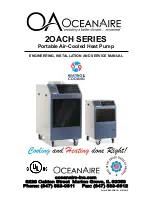
9
C-4.4) Wire Size:
Consult a qualified electrician for proper wire size if additional
power cable length is required. See table for electrical
information.
SECTION: D START-UP OPERATION
D-1) Check Voltage and Phase:
Before operating pump, compare the voltage and phase
information stamped on the pump identification plate to the
available power.
D-2) Check Pump Rotation:
Before putting pump into service for the first time, the motor
rotation must be checked. Improper motor rotation can
result in poor pump performance and can damage the motor
and/or pump. To check the rotation, suspend the pump
freely, momentarily apply power and observe the “kickback”.
“Kickback” should always be in a counter-clockwise direction
as viewed from the top of the pump motor housing.
D-2.1) Incorrect Rotation for Three-Phase Pumps:
In the event that the rotation is incorrect for a three-phase
installation, interchange any two power cable leads at the
control box.
DO NOT
change leads in the cable housing in the
motor. Recheck the “kickback” rotation again by momentarily
applying power.
D-2.2) Incorrect Rotation for Single-Phase Pumps:
In the unlikely event that the rotation is incorrect for a single
phase pump, contact a Barnes Pumps Service Center.
D-3) Identification Plate:
Record future serial plate information in the “NOTES” section.
D-3.1) Pump-Down Test:
After the pump has been properly wired and lowered into the
basin, sump or lift station, it is advisable to check the system
by filling with liquid and allowing the pump to operate through
its pumping cycle. The time needed to empty the system, or
pump-down time along with the volume of water, should be
recorded on the start-up report.
SECTION E: PREVENTATIVE MAINTENANCE
As the motor is oil filled, no lubrication or other maintenance
is required, and generally Barnes Pumps will give very
reliable service and can be expected to operate for years on
normal sewage pumping without failing. In our experience
attempts at preventative maintenance are more likely to
reduce, rather than extend the life of our pumps. However,
if you are inclined to perform preventative maintenance, the
following are the steps that should be performed.
1) Inspect motor chamber for oil level and contamination
and repair as required per section F-1.
2) Inspect impeller and body for excessive build-up or
clogging and repair as required per section F-2.
3) Inspect motor and bearings and replace as required
per section F-3.
4) Inspect seal for wear or leakage and repair as required
per section F-4.
SECTION F: SERVICE AND REPAIR
NOTE: All item numbers in ( ) refer to Figures 15 thru 18.
CAUTION ! - Operating pump builds up heat and
pressure; allow time for pump to cool to room
temperature before handling or servicing. Slowly
remove pipe plug prior to servicing as housing
may be pressurized.
F-1) Lubrication:
Anytime the pump is removed from operation, the cooling oil
in the motor housing (6) should be checked visually for oil
level and contamination.
F-1.1) Checking Oil:
Motor Housing -
To check oil, set unit upright. Remove pipe
plug (39) from motor housing (6). With a flashlight, visually
inspect the oil in the motor housing (6) to make sure it is
clean and clear, light amber in color and free from suspended
particles. Milky white oil indicates the presence of water. Oil
level should be just above the motor when pump is in vertical
position.
F-1.2) Testing Oil:
1.) Place pump on it’s side, remove pipe plug (39), from motor
housing (6) and drain oil into a clean, dry container.
2.) Check oil for contamination using an oil tester with a
range to 30 Kilovolts breakdown.
3.) If oil is found to be clean and uncontaminated (measuring
above 15 KV. breakdown), refill the motor housing as per
section F-1.4.
4.) If oil is found to be dirty or contaminated (or measures
below 15 KV. breakdown), the pump must be carefully
inspected for leaks at the shaft seal (28), cable assemblies
(16) and (56 if used), square ring (27) and pipe plug (39),
before refilling with oil. To locate the leak, perform a
pressure test as per section F-1.3. After leak is repaired,
dispose of old oil properly, and refill with new oil as per
section F-1.4.
F-1.3) Pressure Test:
Pumps that have had the oil drained from the Motor
Housing -
Apply pipe sealant to pressure gauge assembly
and tighten into pipe plug hole (See Figure 3). Pressurize
motor housing to 10 P.S.I. Use soap solution around the
sealed areas and inspect joints for “air bubbles”.
FIGURE 4
Summary of Contents for Barnes DS Series
Page 15: ...15 FIGURE 15 CONTIUED ...
Page 17: ...17 FIGURE 16 EH L Series Single Seal ...
Page 18: ...18 FIGURE 17 EH L Series Single Seal Used with Cast Iron Impeller 33 ...
Page 19: ...19 FIGURE 18 EH DS Series Double Seal ...
Page 20: ...20 FIGURE 19 EH DS Series Double Seal 66 USED WITH CAST IRON IMPELLER 33 ...
Page 23: ...23 Notes ...
Page 24: ...24 Notes ...










































